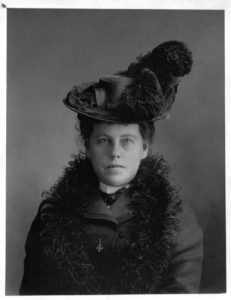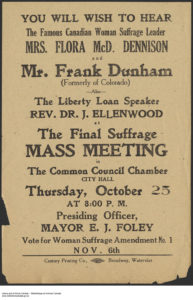Week 9 – Gendered Life at Home
9.1 Early Women’s Movement(s) in Canada
Nancy M. Forestell; Department of History; and St. Francis Xavier University

Alongside and sometimes overlapping with the various social reform causes which emerged in the latter part of the part of the 19th century was the first wave of the Canadian feminist movement. While historians once identified the creation of the Toronto Women’s Literary Society in 1876 as marking the official origin of a women’s movement, more recent scholarship indicates that a variety of women and organizations were engaged in pursuits related to fair treatment and equal rights at least several decades earlier. The specific context of British North America as a settler society shaped by histories of colonialism and slavery had a significant influence on women’s activism from the outset. Belated acknowledgement is now being given to the Indigenous roots of the first wave in North America with documented cases of Aboriginal women demonstrating a critical gender consciousness, acting “in what they perceived to be their own best interests as women as human beings,” and most often to combat the deleterious consequences of colonialism.[1] One prominent example involved the Anishinaabe woman, Nahebahwequa (also known as Catherine Sutton), who protested in 1860 against her dispossession from land she considered a birthright, an event that arose because she had married a non-Aboriginal man. Another key element in the genesis of feminist activism was the ongoing legacy of slavery and female engagement in international abolitionist networks. By the mid-19th century, concerns about the injustices of slavery became increasingly connected with another kind of bondage seen to be experienced by women. It remains unclear the extent to which Black and White female abolitionists were able to easily or consistently overcome the racial divide, but there is a record of mixed race attendance at lectures on anti-slavery and women’s rights as well as mutual support for integrated education in the 1850s and 1860s. These initiatives were accompanied by efforts to secure women’s property rights, the quest for higher education, and the formation of female-exclusive church organizations. Altogether, they laid the basis for women to pursue the attainment of additional rights and play a more significant role in public campaigns for social reform. As in other national contexts, there was not a singular women’s movement in Canada as such; rather, a diverse range of activists who dedicated themselves to a wide array of political, social, economic, and cultural issues.
In the latter part of the 19th century and continuing into the 20th century, two main arguments were put forward by feminists to secure greater civil and political rights, and to achieve greater influence for Canadian women in civil society. One was premised on an equal rights ethos that women and men shared a common humanity, and hence, women should be able to attend university, gain access to selection occupations, vote, and etc. as a matter of natural justice. The other emphasized women’s differences from men, and in particular that their near universal role as mothers specially equipped them to participate in a wide range of reform and political campaigns. Referred to as maternal feminism, this form of argument emphasized that women could apply the knowledge and attributes they acquired as mothers to address various inequities and social ills. While some female activists solely employed one position over the other, many strategically used both. Nonetheless, those who came to predominate among the mainstream women’s organizations, namely middle-class Anglo-Celtic Protestant women, most closely identified with maternal feminism. They were especially prevalent in the first national umbrella women’s organization, the National Council of Women of Canada (NCWC), formed in 1893. They were not the only ones of course, as francophone Catholic women who became part of the provincial group, the Fédération National Saint-Jean-Baptiste (FNSB), founded in 1907 also saw themselves as maternal feminists.[2]

One of the central issues of the first wave was the struggle for female suffrage which involved a protracted campaign with feminist activists laying claim to full political citizenship. While single-issue suffrage groups in Canada remained relatively small and mainly confined to urban centres until the turn of the 20th century, the large female prohibition group the Women’s Christian Temperance Union (WCTU) was a vocal proponent from the 1870s onward. As with a number of other women’s reform groups at the time, the WCTU did not view the attainment of female suffrage as the primary goal in and of itself, but rather as a means to achieve greater political influence for social improvement. Although the suffrage campaign was dominated for the most part by Anglo-Celtic bourgeois reformers, other groups of women participated. For example, female immigrants from Iceland were supporters from early on, as were women originally from Finland, especially after their home country granted women in the vote in 1906. In the specific case of Quebec, the staunch opposition of the Catholic church to women’s enfranchisement combined with the higher priority female reformers gave to advances in their legal rather than political status, meant that support for women’s suffrage was more muted there and the campaign longer.
At the federal level, decades of struggle resulted in the achievement of a partial franchise with the passage of the Wartime Elections Act in 1917. Against the backdrop of World War I, this legislation granted the vote to the female relatives of Canadian soldiers, a large majority of whom were of British ancestry, and withheld the vote to any immigrant citizen from enemy countries who had been naturalized after 1902. These provisions in the legislation not only meant that significant a proportion of non-British immigrants were left out entirely, but also that French Canadians were greatly under-represented among the women who were enfranchised. Although universal adult suffrage was introduced the next year, select populations of women and men were explicitly left disenfranchised: Aboriginal people, as well as Chinese, Japanese, and Indian immigrants.

Other key issues garnered the time and attention of feminists beyond the vote. Working-class women, on occasion in concert with middle-class allies, attempted to oppose the inequities of industrial capitalism and inequities within the labour movement. They also specifically agitated as wives and mothers protesting high consumer prices. Farm women lobbied for legislative changes which would allow them greater financial independence and power especially as related to homestead rights and dower laws. There were still other efforts to raise the moral tone of Canadian society primarily by Euro-Canadian middle-class women. These feminists were not alone in this battle, but far more than others, they raised concerns particular to the situation of women and with a view to altering existing gender relations through the attainment of a single moral standard. Social hierarchies of class, race, religion, and colonial status were at times questioned and contested during the first wave but far more they were unquestioned and re-affirmed.[3]
Key Points
- Aboriginal women were early campaigners for women’s rights as regards property.
- Legal and property rights were a continuing focus for several generations of post-Confederation women, especially in Quebec.
- The movement to abolish slavery provided opportunities for women to develop activist and political skills and for alliances that crossed racial lines.
- First wave feminism engaged ideas like equal rights and maternal feminism: the first emphasizing the similarities between men and women; the latter highlighting differences based on motherhood.
Attributions
Figure 3.39
Mrs. Willoughby Cummings (Emily McCausland Cummings) Toronto corresponding secretary of the National Council of Women of Canada by Library and Archives Canada is in the public domain. This image is available from Library and Archives Canada under the reference number 3214496.
Figure 3.40
National Council of Women group at Rideau Hall, Ottawa, Ont. by Library and Archives Canada is in the public domain. This image is available from Library and Archives Canada under the reference number 3366133.
Figure 3.41
Woman Suffrage: You will wish to hear the Canadian woman suffrage leader Flora McDonald Dennison and Mr. Frank Dunham, Thursday, October 25, 8:00 p.m. by Library and Archives Canada is in the public domain. This image is available from Library and Archives Canada under the access number 1984-4-917.
- Jean Barman, “Indigenous Women and Feminism on the Cusp of Contact,” in Indigenous Women, and Feminism: Politics, Activism, Culturei, eds. Cheryl Zuzack et al. (Vancouver: University of British Columbia Press, 2010): 93. ↵
- Karine Hébert, “A Maternalist Organization in Quebec: The Fédération Nationale Saint-Jean-Baptiste and the Struggle for Women’s Suffrage,” in Quebec Since 1800: Selected Readings, ed. Michael Behiels (Toronto: Irwin, 2002): 461-491. ↵
- Nancy Forestell with Maureen Moynagh, eds., Documenting First Wave Feminisms: Canada — National and Transnational Contexts, Volume 2 (Toronto: University of Toronto Press, 2013). ↵

